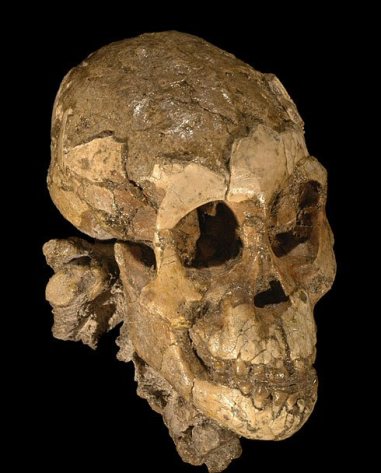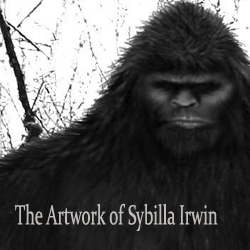Was Lucy’s Child More Apelike?
Posted by: Loren Coleman on September 21st, 2006
Click on image for full size version
According to a new study published on September 21st in Nature, what is being called "Lucy’s child" or "Selam," may change how human-like we consider some Australopithecus species. Has the picture of "Lucy" – Australopithecus afarensis – been too humanlike? Could some unknown hairy hominoid reports from Africa be relicts of australopithecines, after all?
Tracy Press writing for the Associated Press, notes, in part:
The 3.3-million-year-old fossil of a 3-year-old child could shed new light on the evolution of modern humans’ earliest ancestors.
NEW YORK — In a discovery sure to fuel an old debate about our evolutionary history, scientists have found a remarkably complete skeleton of a 3-year-old female from the ape-man species represented by “Lucy.”
The remains found in Africa are 3.3 million years old, making this the oldest known skeleton of such a youthful human ancestor.
“It’s a pretty unbelievable discovery… It’s sensational,” said Will Harcourt-Smith, a researcher at the American Museum of Natural History in New York who wasn’t involved in the find. “It provides you with a wealth of information.”
For one thing, it gives new evidence for a contentious feud about whether this species, which walked upright, also climbed and moved through trees easily.
The species is Australopithecus afarensis, which lived in Africa between about 4 million and 3 million years ago. The most famous afarensis is Lucy, discovered in Ethiopia in 1974, a creature that lived about 100,000 years after the newfound specimen.
The new find is reported in Thursday’s issue of the journal Nature by Zeresenay Alemseged of the Max Planck Institute for Evolutionary Anthropology in Leipzig, Germany; Fred Spoor, professor of evolutionary anatomy at University College London, and others.
The skeleton was discovered in 2000 in northeastern Ethiopia. Scientists have spent five painstaking years removing the bones from sandstone, and the job will take years more to complete.
Judging by how well it was preserved, the skeleton may have come from a body that was quickly buried by sediment in a flood, the researchers said.
“It’s a once-in-a-lifetime find,” said Spoor.
The skeleton has been nicknamed “Selam,” which means “peace” in several Ethiopian languages.
Most scientists believe afarensis stood upright and walked on two feet, but they argue about whether it had ape-like agility in trees.
That climbing ability would require anatomical equipment like long arms, and afarensis had arms that dangled down to just above the knees. The question is whether such features indicate climbing ability or just evolutionary baggage. The loss of that ability would suggest crossing a threshold toward a more human existence.
Spoor said so far, analysis of the new fossil hasn’t settled the argument but does seem to indicate some climbing ability.
While the lower body is very human-like, he said, the upper body is ape-like:
—The shoulder blades resemble those of a gorilla rather than a modern human.
—The neck seems short and thick like a great ape’s, rather than the more slender version humans have to keep the head stable while running.
—The organ of balance in the inner ear is more ape-like than human.
—The fingers are very curved, which could indicate climbing ability, “but I’m cautious about that,” Spoor said. Curved fingers have been noted for afarensis before, but their significance is in dispute.
A big question is what the foot bones will show when their sandstone casing is removed, he said. Will there be a grasping big toe like the opposable thumb of a human hand Such a chimp-like feature would argue for climbing ability, he said.
Yet, to resolve the debate, scientists may have to find a way to inspect vanishingly small details of such old bones, to get clues to how those bones were used in life, he said.
Bernard Wood of George Washington University, who didn’t participate in the discovery, said in an interview that the fossil provides strong evidence of climbing ability. But he also agreed that it won’t settle the debate among scientists, which he said “makes the Middle East look like a picnic.”
Overall, he wrote in a Nature commentary, the discovery provides “a veritable mine of information about a crucial stage in human evolutionary history.”
About Loren Coleman
Loren Coleman is one of the world’s leading cryptozoologists, some say “the” leading living cryptozoologist. Certainly, he is acknowledged as the current living American researcher and writer who has most popularized cryptozoology in the late 20th and early 21st centuries.
Starting his fieldwork and investigations in 1960, after traveling and trekking extensively in pursuit of cryptozoological mysteries, Coleman began writing to share his experiences in 1969. An honorary member of Ivan T. Sanderson’s Society for the Investigation of the Unexplained in the 1970s, Coleman has been bestowed with similar honorary memberships of the North Idaho College Cryptozoology Club in 1983, and in subsequent years, that of the British Columbia Scientific Cryptozoology Club, CryptoSafari International, and other international organizations. He was also a Life Member and Benefactor of the International Society of Cryptozoology (now-defunct).
Loren Coleman’s daily blog, as a member of the Cryptomundo Team, served as an ongoing avenue of communication for the ever-growing body of cryptozoo news from 2005 through 2013. He returned as an infrequent contributor beginning Halloween week of 2015.
Coleman is the founder in 2003, and current director of the International Cryptozoology Museum in Portland, Maine.











I think it is amazing that science is supposed to go where science leads…but often (I guess like a lot of other things) pre-conceived notions ‘lead’ them. I often look at these things and laugh at how ‘little’ they find and then ‘humanize’ the objects. There has been a lot of debate on ‘lucy’…especially with regards to locations of fragments, depths of fragments, as well as mixing …and there was a group of ‘evolutionary’ scientists that concluded it was no more than a type of pygmy chimp whose ‘ancestors’ still roam the plains. As one poster often eludes…follow the $$$ and that is where the opinions of scientist will let their studies draw their conclusions…
There is money in anthropology? Scientific opinion swayed by lobbyists? Maybe I should get into that field, and get rich by making preposterous declarations of how afarensis made the tranistion from arborial to terrestrial by adaptation to the changing evironment(ie. the lose of trees and the growing savanna), as evidenced by the hyoid bone, though the true indicator will be if the degree of opposability of the big toe. So any way, maybe if I study hard and have faith in my own mind, I can become a rich anthropologist.
I don’t think brineblank was talking about the average hourly rate of your local anthropologist. It’s the money that goes to support museums, dig sites, lectures, magazine articles and even into the production of films like Rise of Man, and Origin of Species.
Think about it, we’ve been fed the same diet of what our family tree is suppose to look like for a very long time. When in fact, there is little evidence available to make it all fit nice and neat.
I’m no expert, but I believe there are huge holes, and room for different ideas when it comes to the history of where we came from.
The history of anthropology is full of mistakes, and with further study, ideas change, the biggest roadblock is the power of accepted thought. Piltdown man made many respected authorities look like fools. Going against accepted ideas is academic suicide, but eventually new ideas become accepted. The “family tree” is full of holes, and with further digs and better understanding, the holes will fill in. I would just about say all of science is tentative, even the laws of nature are subject to certain conditions. It is through the power of human thought and reasoning that we discover what our world is, and was. And there will aways be those people who will stand by a dogmatic theory or idea, that will stagnate the flow of scientific advancement. People should use their minds to think with, not just store information, and make their own conclusions,(and not take on faith what Sir A. Keith says). As for the aformentioned tendency to “humanize” anthropological finds, are we guilty of anthropomorphism? Maybe it would be wrong to assume that someone who buys a newspaper can read, maybe they are just looking at the comics.
There is a very interesting line in that story.. “While the lower body is very human-like, he said, the upper body is ape-like…”
Now, it’s a very long stretch, in fact a totally unsupported one, to draw any connection between this fossil and sasquatch. However, the phrase caught in my mind because Dr. John Napier rejected the PG film on the grounds the animal looked like a half-and-half chimera: the lower body was humanlike, while the upper body was apelike. (See his book Bigfoot).
Food for thought…
Thanks bennymac…I was implying that. Sometimes in order to secure funding for current or future exploration one has to ‘be careful’ where science leads. Sorry but it is a fact of life and I have crossed paths in my educational career with folks that have (sadly) admitted to this. (And I’m sure some will rant and rave that those people aren’t true scientists and don’t represent the community, etc….but hey, look at our politicians and how they actually operate vs. how they are supposed to operate.) Science is supposed to lead to a finding of facts but often in certain areas of science the outcome is picked first and then science tries to force the round peg in the square hole. I have also had profs in these arenas that have said that they know there are many misconceptions that still ‘hang out’ but it just takes too much time to turn the tide because there is so much current information to try to deal with ‘and that people who are ‘really interested in those areas’ pick up on the info at some time or other. And while some (dare I say most) scientists claim that they allow for ‘science’ to correct their findings….sometimes they are a little slow in coming around and the corrections end up on page 47D with a two-sentence blurb.
I don’t really see what the problem is here… the fossil shows a mosaic of pongid (apelike) and hominid traits, as would be expected for such an early ancestor. There is nothing new about “Lucy”‘s tree-climbing adaptations either… this ability may have persisted through Homo habilis.
The quoted report is also filtered through the popular press, with the inevitable simplifications and distortions. I intend to read the original Nature article.
This is all what I have been saying all along. I’m pretty sure when Lucy was first dug up the researchers went “Darn, not an other monkey,” and then that day or so got a letter from their funders asking if they found anything with a big hint about the funds possibly running out and that’s when they pulled Lucy’s bones out and yelled at the top of their lungs, “Look what we discovered….” The unfortunate thing about teaching evolution in schools is that the teachers have to teach it as a fact (over all and the specifics) when it is only a running theory. In fact the state of Kansas decided recently to not teach macro evolution (changing from one species to another) because the evidence is shotty at best, but still taught micro evolution (adaptation within a species for survival). The experts and master evolutionists in Britain and many around the world hounded them in almost a grade school manner. Don’t forget that at least for a while public schools also included Nebraska man. I’m not sure if they still teach about him today, it was over a decade ago that I had to hear all this. Nebraska man turned out to be just a tooth, and one that belongs to a living group of boars. Even peking man is questionable. That is why the remains were in transit when they disappeared. The remains were presented to an anthropologist, who thought he saw evidence of filing. Besides, one thing I have learned about what is being taught about evolution that isn’t necessarily true is that the group that is suppose to be the between species doesn’t always go extinct. And just the let these people know, when I was much younger I was quite the tree climber. No, I may not have swung like the apes do, but I wasn’t far behind them with my own way of getting around up there. Say, what are they going to say when the big toe is that of a great ape? I also find it interesting that the fossil is being pulled out of sediment from a “flood”.
oh, might I just add that that skull looks more ape than man. I’m sorry, but I just cannot accept that one of my ancestors was that ugly.
Maybe we came from apes. Don’t know. I do know in the show Origins of man, They had to do a lot of cutting and reshapeing of Lucy’s hips, to claim she was an ape that walked upright. Money, fame, and the need of grants can have alot of influance in decisions.
“…but I just cannot accept that one of my ancestors was that ugly.”
Compared to the lobe-finned fishes?
Matt Bille
“Ugly” is in the eye of the beholder. Maybe people would have less trouble with evolution if we were descended from something we consider handsome and noble, like horses. But as they say, “you can choose your friends, but you’re stuck with your relatives.”
Anthropology is evolution, as time goes on, the finds help further clarify the things that are hypothesized or not clearly understood and heavily debated. Just like bigfoot (or any other variations that have been spotted and reported), you don’t know exactly what you’ve got until you have something to study. With this new archeological find, it sounds like they are able to further clarify what Lucy was. But there are always a multitude of perceptions so of course there will never be total agreement. BUT, the capture of a live BF is a whole different story. You can’t deny the existence of it once one has been captured! Of course the debate will continue with what it is and where in the family tree it resides (and that is why I was intrigued by the earlier post on that subject), but that is the lesser of two evils. Now where did that dude go off with the Yarwen?
I think we all have to remember that most of anthropology (paleontology, etc.) are fields in which educated people spend a lot of time guessing about things they’ll never have to really prove. So, given that, there is a huge margin for error in any scientific extrapolation concerning fossil remains’ ability to really give us a complete picture. It just can’t be done so we have to live with what we ‘think’ is a sound conclusion.